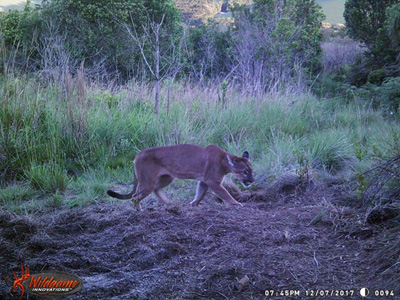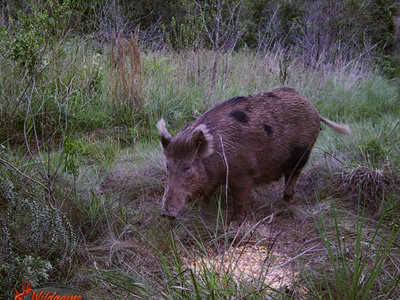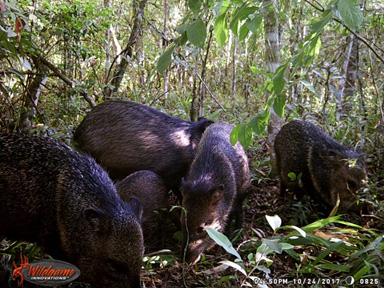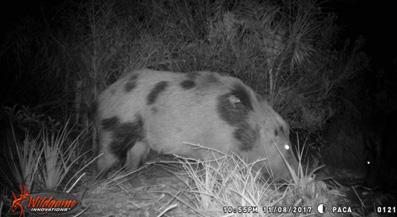PhD research from UFPR indicates that boars may play an important role in the transmission of Brazilian Macular Fever
Reportagem publicada na Gazeta do Povo
Research conducted by PhD student Louise Bach Kmetiuk of the Graduate Program in Cell and Molecular Biology at UFPR showed that all twenty wild boars (Sus scrofa) sampled at Vila Velha State Park were serologically positive for at least one antigen from bacteria of the genus Rickettsia spp., responsible for Brazilian Macular Fever (BMF), a fatal disease transmitted by ticks. The study was accepted for publication in the journal PLOS Neglected Tropical Diseases.
Although capybaras (Hydrochoerus hydrochaeris) are recognized as the main host of ticks vectors of the disease, such as the star tick (Amblyomma sculptum), and amplifiers of the bacterium Rickettsia rickettsii, the main and most deadly causative agent of BMF in Brazil, boars (invasive fauna) appear to be able to carry and disseminate large numbers of capybaras ticks from their natural habitats (pools and riverbanks) to other ecosystems. In addition, population control activities of wild boar by hunting (Regulatory Instruction IBAMA 03/2013) may increase the risk of exposure of controllers and their dogs to these ticks, with consequent exposure to Brazilian Macular Fever.
“The results are impressive and put controllers and other people in the woods where wild boars are in great numbers,” says Professor Alexander Welker Biondo, coordinator of UFPR’s partnership with the Environmental Institute of Paraná (IAP) and the State Park of Vila Velha. According to Juarez Barkoski, manager of the Park, the situation is grave: “Wild boars have had a terrible impact on the fauna and flora of Vila Velha, and this has worsened in recent years, with recent withdrawal of vegetation cover in front of the sandstones, a symbol of our conservation unit”.
The study suggests that there was loss of habitat of native species due to the presence of wild boars in the Park, including reports of peccaries seeking food in cereal plantations present in the buffer zone of the park. The massive presence of the nymphs and adults stages of the Amblyomma brasiliense tick also indicated the overlapping of wild boars with the ecological niche of hounds (Tayassu spp.), Natural hosts of this species of ticks.
The research carried out within the Integrated Protection Conservation Unit Vila Velha State Park is entitled “Population control and sanity of wild boars (Sus scrofa) present in the State Park of Vila Velha”, with the objective of evaluating and monitoring the presence and interaction of the species with the native fauna and flora in this fragment of the Atlantic Forest, as well as its impact on the Unique Health. Other zoonoses, such as toxoplasmosis, leptospirosis and rabies were also tested in wild boars, considered as the preferred source of blood reptile for hematophagous bats after analysis of images obtained by motion cameras installed in various areas of the park.
The results of this study may be important in providing subsidies for the planning of public actions in the prevention of neglected diseases transmitted by vectors, such as Brazilian Macular Fever and other zoonoses, both in agricultural areas with overlapping wild boars, hunting dogs and controllers, also in the natural areas of protected areas.
What? PhD research of the Graduate Program in Cellular and Molecular Biology (UFPR), in a partnership study with the Environmental Institute of Paraná (IAP) and the University of Sao Paulo (USP) for the research of Brazilian Macular Fever and other zoonoses in wild boars, hunting dogs and wild boar controllers.
Where? State Park of Vila Velha-PR and its surroundings (Region of Campos Gerais).
When? April 2019 (NTD PLOS, 2019)
How? Work of sanitary monitoring of wild boars in the State Park of Vila Velha-PR and its surroundings, Region of Campos Gerais, in wild boars, hunting dogs and controllers of wild boars.
Who? PhD student Louise Bach Kmetiuk (telephone 41 99994-2216) and Professor Alexander Welker Biondo at UFPR (telephone 41 98845-8750).

Figure 1. Puma (Puma concolor) at one of the monitoring points in the State Park of Vila Velha-PR. (Source: Researchers of UFPR).

Figure 2. Wild boar (Sus scrofa) in the State Park of Vila Velha-PR. Note that the image was captured at the same tracking point as the previous photo. In Brazil, despite the occurrence of large felids such as the puma, the boars do not have a natural predator that can control their population. (Source: Researchers of UFPR).

Figure 3. Hatch group (Tayassu spp.) in monitored forest area in the State Park of Vila Velha-PR. (Source: Researchers of the Federal University of Paraná).

Figure 4. Wild boar (Sus scrofa) in forest area also occupied by hicks, suggesting habitat overlap. Note the presence of a hematophagous bat performing blood repotto in the animal. (Source: Researchers of UFPR).

